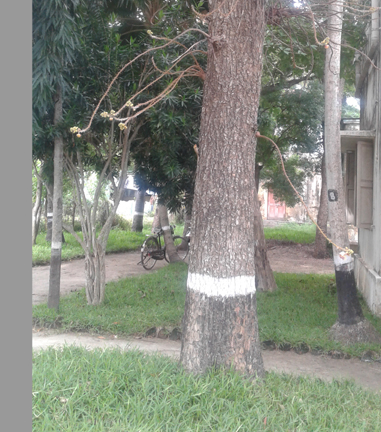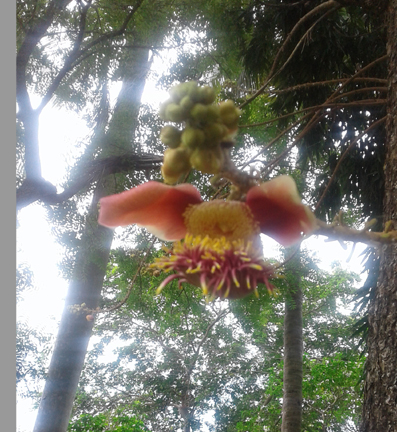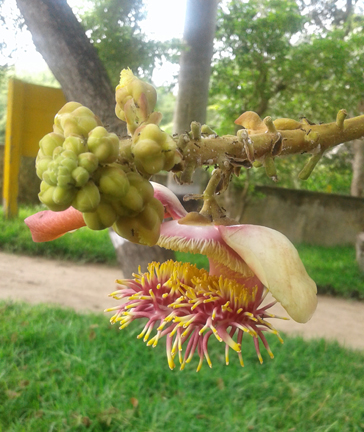Reception by Trees and Bees
-K.Amina Bibi
I am recently transferred to a new place, and my responsibility is Farm Management. I was hesitant to accept the change, to work in an isolated place. New type of work and new people…with heavy heart I went to the new place. The way to the new place was
a stretch of greenery, fresh smell of herbs and gave a feel of entering a serine place. Two giants were receiving me with their unique inflorescence, Nagalinga Poo (in Tamil). I have heard it is seen only in Lord Shiva temples. The trees gave me a Red Carpet
Welcome. It was a Good Beginning for me. From then on every day I noticed a new flower hanging from top, to receive me daily.

I was greatly encouraged by this and started exploring this tree. Here are the facts I thought I should share – Its botanical name is
Couroupita guianensis is part of the family
Lecythidaceae. It grows up to 25 m (82 ft) in height. The “Cannonball Tree” is so called because of its brown cannon-ball-like fruits. The majority of these trees outside their natural environment have been planted as
a botanical curiosity, as they grow very large, distinctive flowers. Its flowers are orange, scarlet and pink in color, and form large bunches measuring up to 3m in length. They produce large spherical and woody fruits ranging from 15 to 24 cm in diameter,
containing up to 200 or 300 seeds a piece.

The tree possesses antibiotic, antifungal, antiseptic and analgesic qualities. The trees are used to cure colds, stomach aches and even Malaria. Juice made from the leaves is used to cure skin diseases. The inside of the fruit can disinfect wounds and
young leaves ease toothache. The fruit emits an unpleasant odor and can be used as an insect repellent just by rubbing it to the skin or clothes.

The flowers are found on thick tangled extrusions that grow on the trunk of the tree; these are found just below the foliage branches which are actually like personally welcoming me daily. I spend few initial minutes of my day with these flowers. Often
I see bees actively doing their duty of pollination. The flowers have no nectar but they do have pollen and as such pollination is done mainly by bees. The pollen comes in two varieties as well, one which is fertile and another which has no obvious reproductive
benefit. The fertile pollen is produced on stamens which rub against the back of bees and is so carried on to another tree. The infertile pollen is bee food.
Heard from the staff the sound of the fruit falling and its smell when rotten is unpleasant. But still the wonders of the natural world are endless and inspiring, and this wonderful tree is indeed a wonder.
(Text and photographs by Amina Bibi. K. Amina Bibi is a Post Graduate in Agriculture with specialization in Plant Breeding and Genetics. She is currently working as Agriculture Officer in Karaikal, Department of Agriculture, Government of Puducherry)